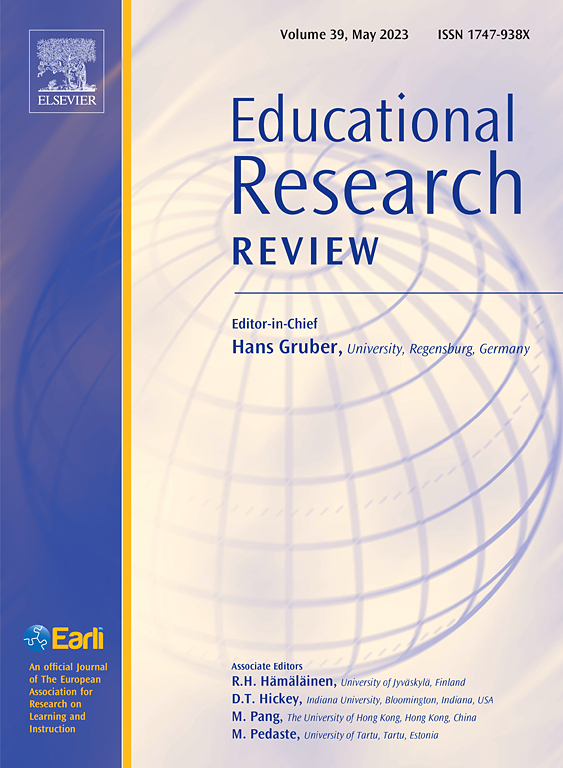What do we know about cyberbullying assessment tools for Primary and Secondary Education students? A systematic review and meta-analytical study
IF 10.6
1区 教育学
Q1 EDUCATION & EDUCATIONAL RESEARCH
引用次数: 0
Abstract
New forms of violence, such as cyberbullying, have emerged partly due to the increased use of technological devices at an early age. This rise in risk situations has led to a proliferation in the number of instruments that assess these behaviors, requiring an exhaustive analysis to determine the contents they address, the age range in which they are validated, their psychometric properties, and the way in which they approach the conceptualization of cyberbullying. To this end, a systematic review and meta-analysis was conducted, obtaining 3859 results in the selected databases (Web of Science, Scopus, PsycInfo, PsicoDoc, ProQuest, Psychology and Behavioural Sciences and PubPsych), which through a screening process, resulted in the analysis of 28 cyberbullying assessment tools that met the established inclusion criteria ((I) scientific articles that were published in peer-reviewed scientific journals; (II) that were validated in the selected age range (Primary or Secondary Education); (III) that addressed cyberbullying; (IV) that were written in English, Spanish or Portuguese; (V) that validity and/or reliability be analyzed). Taking into consideration the meta-analytical approach, the internal consistency of the cyberbullying detection instruments and scales was found to be significant, and the meta-analysis showed satisfactory results. According to the qualitative interpretation of this statistic, all of the aforementioned scales showed reliable results (between 0.84 and 0.90). The data indicated a medium-to-large effect of the precision and reliability of the psychological scales of bullying and cyberbullying.
Furthermore, with regard to the systematic review, it was possible to appreciate the need for the instruments to have a mixed methodology, establishing a connection between the macrosocial and microsocial frameworks. Similarly, it would be appropriate for these tools to address the subject from the age of eight, without combining educational stages or different variables.
我们对中小学学生网络欺凌评估工具了解多少?一项系统回顾和荟萃分析研究
网络欺凌等新形式暴力的出现,在一定程度上是由于在幼年时越来越多地使用技术设备。这种风险情况的增加导致了评估这些行为的工具数量的激增,需要进行详尽的分析,以确定它们所处理的内容、验证它们的年龄范围、它们的心理测量特性以及它们处理网络欺凌概念化的方式。为此,我们进行了系统回顾和荟萃分析,在选定的数据库(Web of Science、Scopus、PsycInfo、PsicoDoc、ProQuest、Psychology and Behavioural Sciences和PubPsych)中获得3859个结果,通过筛选过程,得出28个网络欺凌评估工具的分析结果,这些工具符合既定的纳入标准(1)发表在同行评议科学期刊上的科学文章;(II)在选定的年龄范围内(小学或中学教育)得到验证;(三)针对网络欺凌的;(四)以英文、西班牙文、葡萄牙文书写的;(五)效度和/或信度分析)。考虑到元分析方法,发现网络欺凌检测工具和量表的内部一致性显著,元分析结果令人满意。根据该统计量的定性解释,上述所有量表均显示可靠的结果(在0.84至0.90之间)。数据显示霸凌心理量表和网络霸凌心理量表的准确性和可靠性存在中大型效应。
本文章由计算机程序翻译,如有差异,请以英文原文为准。
求助全文
约1分钟内获得全文
求助全文
来源期刊

Educational Research Review
EDUCATION & EDUCATIONAL RESEARCH-
CiteScore
19.40
自引率
0.90%
发文量
53
审稿时长
57 days
期刊介绍:
Educational Research Review is an international journal catering to researchers and diverse agencies keen on reviewing studies and theoretical papers in education at any level. The journal welcomes high-quality articles that address educational research problems through a review approach, encompassing thematic or methodological reviews and meta-analyses. With an inclusive scope, the journal does not limit itself to any specific age range and invites articles across various settings where learning and education take place, such as schools, corporate training, and both formal and informal educational environments.
 求助内容:
求助内容: 应助结果提醒方式:
应助结果提醒方式:


